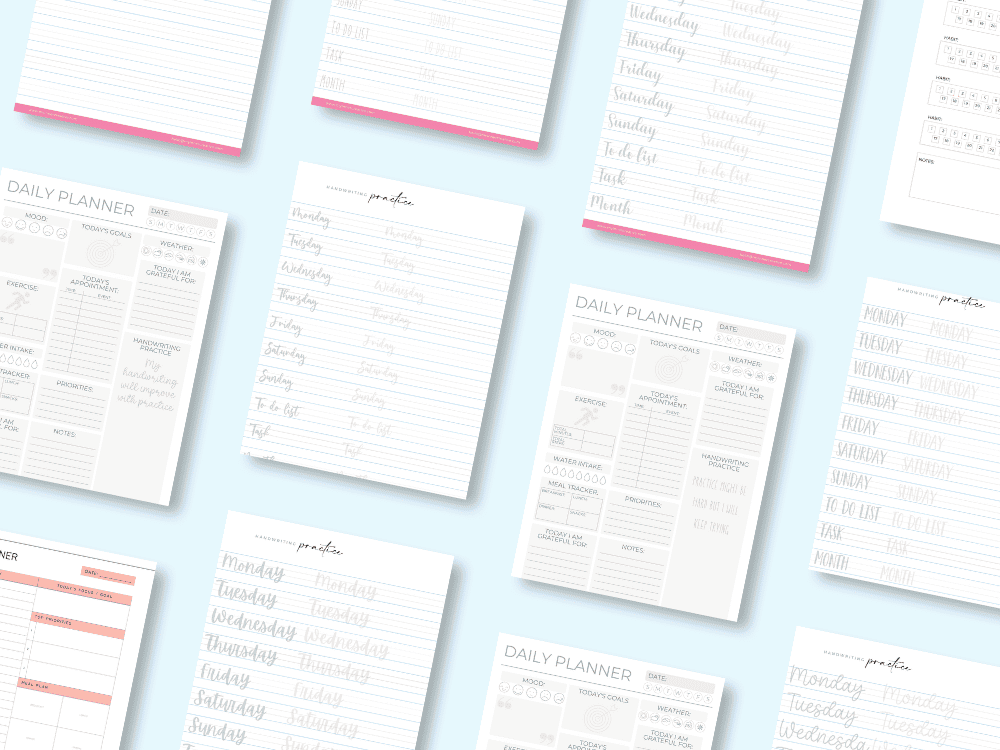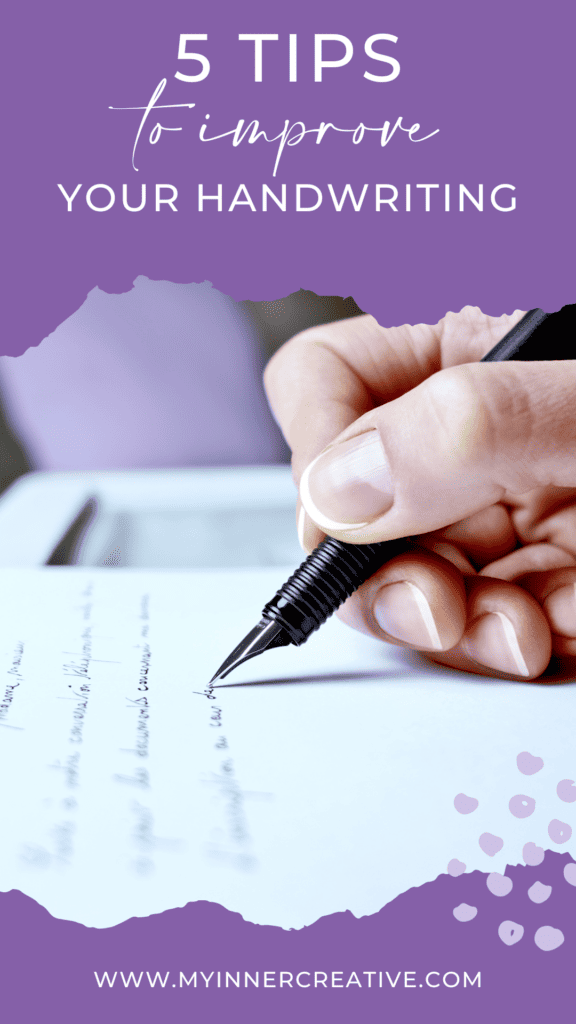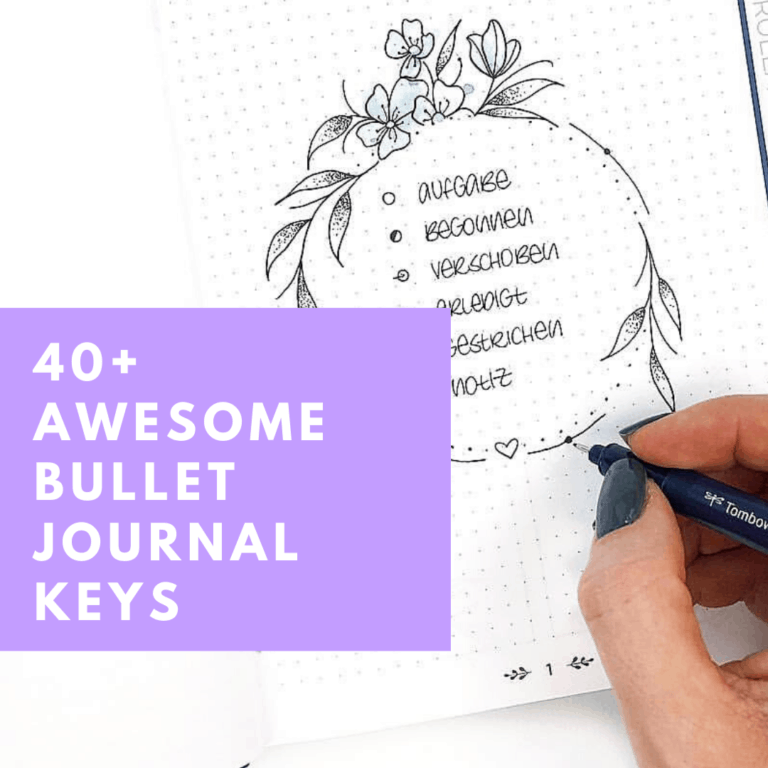Mastering Handwriting Practice: 5 Tips to improve your handwriting in your bullet journal
Elevate your bullet journaling with effective handwriting practice. Discover 5 tips to enhance legibility and creativity in every page. Handwriting is a fundamental skill that has withstood the test of time, even in our digital age. Whether it’s jotting down notes, expressing creativity through art, or personalizing your bullet journal, the way you write can greatly influence how your thoughts are conveyed and received.
In a world saturated with typed text, the art of handwriting stands as a unique form of self-expression. If you’re a bullet journal enthusiast seeking to elevate your journaling experience, enhancing your handwriting can be a rewarding endeavor. In this article, we’ll delve into five effective ways to improve your handwriting and explore why legible and aesthetically pleasing writing is particularly important for the world of bullet journaling.

The Importance of Improving Handwriting for Bullet Journaling
Bullet journaling has gained immense popularity as a versatile method for planning, organizing, and reflecting. At its core, a bullet journal is more than just a planner; it’s a canvas for your thoughts, goals, and creative expressions. Here’s why improving your handwriting is essential for an enriching bullet journaling experience:
- Personalization and Aesthetics: A well-maintained bullet journal is a reflection of your unique personality. Neat and attractive handwriting adds a personal touch that can turn a simple to-do list into an artistic creation. Each stroke of the pen becomes an opportunity to infuse your journal with creativity and flair.
- Readability and Clarity: Bullet journals serve as a repository of essential information, from appointments and tasks to reflections and memories. Clean and legible handwriting ensures that you can easily decipher your entries weeks, months, or even years later. The last thing you want is to struggle to decipher your own writing.
- Efficient Communication: Bullet journaling isn’t just about creating visually pleasing spreads; it’s also a tool for effective communication. Whether you’re jotting down quick notes or planning out your week, clear handwriting ensures that your ideas are accurately conveyed, reducing the chances of misinterpretation.
- Mindfulness and Reflection: Many individuals turn to bullet journaling as a means of mindfulness and self-reflection. The act of writing by hand engages your senses in a way that typing on a keyboard cannot replicate. Improved handwriting transforms the journaling process into a meditative practice, allowing you to immerse yourself fully in your thoughts.
- Boosting Confidence: As you see your handwriting evolve and become more elegant, your confidence in your creative abilities grows. The pride you feel when you flip through your journal and witness your progress is immeasurable. This confidence extends beyond your journal and positively impacts other areas of your life.
Crafting Aesthetic Handwriting Through Dedicated Handwriting Practice
The pursuit of aesthetic handwriting is a journey that requires dedication and deliberate practice. While the allure of beautifully styled letters may seem daunting, the truth is that anyone can achieve it with consistent effort. Handwriting practice is the foundation upon which aesthetic handwriting is built. Here’s how to seamlessly integrate dedicated handwriting practice into your bullet journaling routine:
1. Set Aside Time for Practice: Just as you allocate time for journaling, schedule specific moments for handwriting practice. Whether it’s a brief session before bed or during your morning routine, consistent practice gradually transforms your handwriting from ordinary to extraordinary.
2. Focus on Letter Forms: Paying attention to the formation of individual letters is crucial. Study various lettering styles and select one that resonates with you. Experiment with different sizes, slants, and embellishments to find the aesthetic that aligns with your journal’s overall vibe.
3. Incorporate Practice Prompts: Inject creativity into your handwriting practice by integrating prompts from your bullet journal. Write down inspiring quotes, affirmations, or short journal entries using your chosen handwriting style. This dual-purpose approach combines practice with journal content creation.
4. Gradually Introduce Complexity: Start with basic letters and gradually progress to more intricate forms. Challenge yourself with connecting letters in different ways to develop fluidity in your writing. As you become comfortable, venture into designing headings and titles for your bullet journal pages.
5. Embrace Imperfection: Remember that aesthetic handwriting doesn’t demand perfection. Embrace the quirks and uniqueness of your writing style. It’s the subtle idiosyncrasies that give your handwriting character and distinguish it from others.
6. Seek Inspiration: Draw inspiration from calligraphy artists, online tutorials, and social media platforms dedicated to beautiful handwriting. Observing others’ techniques can provide fresh ideas and motivate you to refine your own style.
7. Monitor Your Progress: Keep a dedicated section in your bullet journal to track your handwriting practice journey. Document milestones, such as when you notice improved consistency or when you successfully integrate a new embellishment into your writing.
Mastering Handwriting: From Practice Sheets to Elegant Calligraphy
In the realm of handwriting, the transformative power of practice cannot be overstated. Whether you’re aiming for neat and consistent letters, exploring the fluidity of cursive, or venturing into the realm of calligraphy, dedicated handwriting practice is your compass. Let’s delve into various aspects of refining your handwriting, from practice sheets to crafting exquisite calligraphy:
Handwriting Practice Sheets: A Foundation of Improvement
For those embarking on the journey of improving their handwriting, practice sheets are akin to a blank canvas awaiting the artist’s touch. These sheets offer structure and guidance as you refine your letter forms and establish muscle memory. Handwriting practice sheets for adults come in various styles, catering to different goals, whether it’s perfecting your cursive, mastering the alphabet, or simply enhancing the neatness of your handwriting.
Exploring Cursive Handwriting: A Graceful Art
Cursive handwriting adds a touch of elegance to your writing style. The rhythmic flow of connected letters transforms words into a visual dance across the page. As you delve into cursive handwriting practice, remember that consistency is key. Use handwriting practice sheets specifically designed for cursive writing to refine your letter connections and achieve that classic cursive flair.
Crafting Handwritten Letters: The Art of Personal Connection
In today’s digital age, handwritten letters stand out as cherished tokens of personal connection. Each stroke of the pen reflects genuine emotion and care. Whether you’re penning heartfelt notes to loved ones or expressing gratitude to friends, handwriting notes holds a unique significance. Utilize handwriting templates to guide your letter-writing journey, ensuring that your sentiments are elegantly conveyed.
Unlocking the World of Calligraphy: A Fusion of Art and Writing
Handwriting calligraphy transcends conventional writing—it’s an art form in its own right. The marriage of precise strokes and creative flair yields visually captivating results. Delve into calligraphy practice sheets to master the intricacies of different calligraphy styles, from traditional to modern. The art of calligraphy requires patience and dedication, but the results are nothing short of mesmerizing.
Handwriting Practice for Adults: A Path of Continuous Growth
The notion that handwriting practice is solely for children is a misconception. Handwriting practice for adults is a journey of continuous growth and refinement. As adults, our unique styles have developed over years, but they are by no means static. Handwriting practice offers a space for self-improvement and adaptation, whether you’re seeking to introduce calligraphic elements or enhance the overall neatness of your writing.
Handwriting Without Tears Cursive: A Graceful Learning Experience
The “Handwriting Without Tears” approach to cursive handwriting emphasizes a seamless transition from print to cursive. The method recognizes the importance of muscle memory and cognitive understanding. Utilizing handwriting practice sheets aligned with this approach provides a structured learning experience, making cursive writing accessible and enjoyable.
In the realm of handwriting, practice is the common thread weaving through all these endeavors. From meticulously crafted calligraphy to the heartfelt sincerity of handwritten letters, every stroke of the pen is a step toward self-expression and refinement. So, whether you’re perfecting your print, diving into cursive, or embracing the art of calligraphy, remember that your handwriting journey is a canvas waiting to be transformed through the power of dedicated practice.
TIP 1: Practice Regularly: Building Muscle Memory for Neater Handwriting
Improving handwriting is akin to nurturing a garden; it flourishes with consistent care. Regular practice is the cornerstone of handwriting enhancement. Just as a musician practices scales and a painter refines brushstrokes, carving out time each day for handwriting practice cultivates the precision and finesse your writing deserves. Dedicate a specific time slot to this practice, whether it’s a few minutes before bed or during your morning routine. Let your pen dance across the page, shaping letters, sentences, or even brief paragraphs.
Through consistent practice, you’re not merely training your hand; you’re cultivating muscle memory—a phenomenon where your hand subconsciously remembers the movements required for specific letters and formations. Over time, this practice transforms into the gift of neater, more elegant handwriting. So, embrace each practice session as an opportunity for growth, knowing that your commitment will blossom into writing that captures the eye and imagination.
TIP 2: Slow Down: The Art of Deliberate Writing
In a world that values speed, slowing down your writing pace might feel counterintuitive. However, the art of handwriting thrives on deliberate, unhurried strokes. Rushing through writing often begets messy and illegible letters. Picture a calligrapher delicately crafting each stroke with precision—there’s a sense of intentionality that underpins their every movement.
As you practice, deliberately slow down. Allow your hand to savor the formation of each letter, paying attention to the graceful connection between them. By pacing yourself, you create a space for mindfulness, transforming writing from a mundane task into a meditative practice. Over time, this measured approach intertwines with your muscle memory, leading to a refined and graceful handwriting style.
TIP 3: Use Proper Grip: The Elegance of Controlled Penmanship
The grip with which you hold your pen wields remarkable influence over your handwriting’s outcome. The tripod grip, a well-regarded technique, involves holding the pen between your thumb and the first two fingers. This grip offers controlled movement and precision, preventing excessive strain on your hand. Avoid clenching the pen too tightly—this not only hampers fluidity but also leads to fatigue and discomfort.
Imagine your pen as an extension of your hand, guided by your intentions. By mastering the tripod grip, you’re empowering your hand to dance across the page with elegance and grace. With each stroke, you’re not just creating letters; you’re creating an experience that’s both enjoyable for you and visually appealing to others.
TIP 4: Pay Attention to Letter Formation: The Blueprint of Legibility
Neat handwriting isn’t just about aesthetics—it’s about effective communication. Clear, consistent letter formation is the foundation of legibility. Research the correct way to form each letter and practice diligently. Observe the height, width, and slant of letters, noting the subtle details that transform ordinary writing into an organized masterpiece.
Consider each letter a piece of an intricate puzzle. With practice, these puzzle pieces align flawlessly, revealing a coherent and visually pleasing result. The deliberate act of forming letters becomes a mindfulness exercise, where each stroke is a brushstroke on the canvas of your page.
TIP 5: Experiment with Styles: Unveiling Your Unique Handwriting Identity
The beauty of handwriting lies in its diversity. Your handwriting is an extension of your individuality, akin to a fingerprint. Embrace the freedom to experiment with various styles until you uncover the one that resonates most with you. Whether you lean towards print or cursive, large or small, slanted or upright, allow your natural inclinations to guide you.
Think of this experimentation as a journey of self-discovery. As you explore different styles, you’re not just refining your handwriting; you’re unveiling a unique facet of your identity. Don’t shy away from modifications that enhance readability or add a personal touch. Remember, your handwriting isn’t static—it evolves with your growth and creative exploration.
Embracing the Journey of Improvement
In the realm of handwriting, growth emerges from dedication, not haste. As you practice regularly, slow down, master your grip, perfect letter formation, and explore styles, you’re embarking on a transformative journey. Embrace this journey with patience and optimism. Celebrate the small victories—the slightly rounder ‘o’, the more graceful ‘r’, the smoother connections. These are the stepping stones toward the elegant handwriting you envision.
The challenges you encounter at the outset are natural, the ripples that precede the calm. With each practice session, you’re nourishing the soil from which your handwriting flourishes. Through persistence, your handwriting will metamorphose, reflecting the care and commitment you’ve invested. As your pen traces words on the page, it’s not just ink—it’s your unique mark, a testament to your dedication and the embodiment of your personal style. So, embrace the journey, relishing the dance of ink and paper, and let your handwriting evolve into a masterpiece that’s uniquely yours.
Elevate Your Bullet Journaling Experience: Carving Out Space for Handwriting Practice
A bullet journal is more than just a planner; it’s a canvas for your thoughts, dreams, and creativity. Amidst the structured grids and meticulously tracked tasks, there’s a hidden gem waiting to be unearthed—your handwriting. As you journey towards enhancing your handwriting, consider integrating this pursuit into your bullet journal. Here’s how you can seamlessly make time for handwriting practice within the pages of your journal:
1. Create a Handwriting Practice Section: Dedicate a dedicated section in your bullet journal to handwriting practice. This space can be as simple as a few blank pages earmarked for honing your writing skills. Label it creatively—perhaps “Calligraphy Chronicles” or “Elegant Expressions”—to infuse a touch of excitement.
2. Set a Practice Schedule: Just as you schedule tasks and appointments, allocate specific time slots for handwriting practice. Whether it’s a brief session each morning or a longer practice on weekends, consistency is key. Let your journal be a silent partner in this journey, reminding you of the commitment you’ve made.
3. Integrate Practice Prompts: Intertwine handwriting practice with your journal content creation. Use practice prompts that align with your journal’s theme or your current goals. Write down inspirational quotes, daily affirmations, or reflections using your evolving handwriting style. This fusion of practice and journaling weaves a seamless tapestry of growth.
4. Track Progress and Milestones: As you embark on your handwriting improvement journey, your bullet journal becomes a chronicle of progress. Create a dedicated page to document milestones—when you notice smoother connections, improved consistency, or even the first time you experiment with calligraphic elements. This visual record serves as a source of motivation and a testament to your dedication.
5. Transform Headers and Titles: Elevate the visual appeal of your bullet journal by applying your evolving handwriting to headers and titles. Whether you’re planning your weekly spread or documenting your latest adventure, let your improved handwriting infuse charm and elegance into every page.
6. Design Handwriting Templates: Craft custom handwriting templates that cater to different styles and sizes. These templates can serve as guides for practicing specific letters or calligraphic flourishes. When you’re ready to apply these elements to your journal, they seamlessly integrate with the rest of your content.
7. Embrace Imperfection: Remember that your bullet journal is a reflection of your journey, not a showcase of perfection. Embrace the imperfections, the smudges, and the wobbly lines. Each mark is a testament to your growth and commitment. This mindset fosters a genuine and forgiving approach to practicing within your journal.
In the realm of bullet journaling, every page is a canvas for self-expression and growth. By dedicating a corner of your journal to handwriting practice, you’re intertwining this journey with your larger narrative. As you open your journal to each new day, you’re greeted not only by tasks and plans but also by the opportunity to refine your writing style. Your handwriting evolves alongside your thoughts, goals, and aspirations, resulting in a bullet journal that’s not just organized but also artistically enriched. So, embark on this creative voyage, letting your pen dance across the pages of your journal, leaving behind a trail of growth and elegance.







